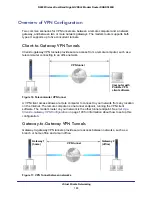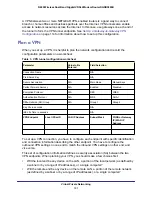
Virtual Private Networking
111
N600 Wireless Dual Band Gigabit VDSL2 Modem Router DGND3800B
e.
In the
Hash Alg
drop-down list, select
SHA-1
.
f.
In the
SA Life
drop-down list, select
Unspecified
.
g.
In the
Key Group
drop-down list, select
Diffie-Hellman Group 2
.
6.
Configure the VPN client key exchange proposal.
In this step, you provide the type of encryption (DES or 3DES) to be used for this
connection. This selection has to match your selection in the modem router configuration.
a.
Expand the Key Exchange subheading by double-clicking its name or clicking the
+
symbol. Then select
Proposal 1
below Key Exchange.
b.
In the
SA Life
drop-down list, select
Unspecified
.
c.
In the
Compression
drop-down list, select
None
.
d.
Select the
Encapsulation Protocol (ESP)
check box.
e.
In the
Encrypt Alg
drop-down list, select the type of encryption that is configured for
the encryption protocol in the modem router, as listed in
Table
3
on page
101. This
example uses Triple DES.
f.
In the
Hash Alg
drop-down list, select
SHA-1
.
g.
In the
Encapsulation
drop-down list, select
Tunnel
.
h.
Leave the
Authentication Protocol (AH)
check box cleared.
7.
Save the VPN client settings.
In the Security Policy Editor window, select
File > Save
.
After you have configured and saved the VPN client information, your computer
automatically opens the VPN connection when you attempt to access any IP addresses
in the range of the remote VPN router’s LAN.
8.
Check the VPN connection.
To check the VPN connection, you can initiate a request from the remote computer to the
modem router’s network by using the Connect option in the NETGEAR ProSafe menu
bar. The NETGEAR ProSafe client reports the results of the attempt to connect. Since the






























